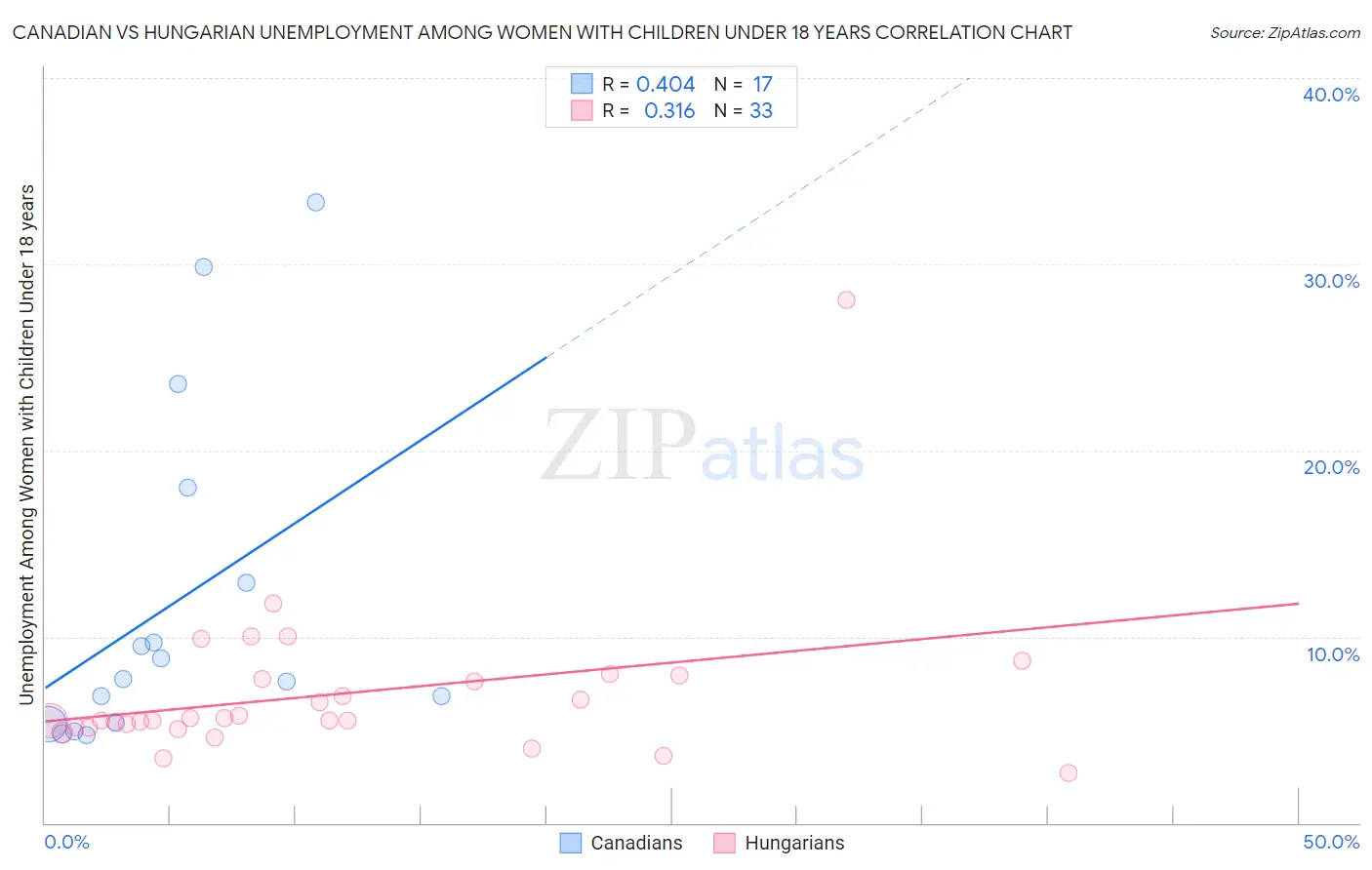Canadian vs Hungarian Unemployment Among Women with Children Under 18 years
COMPARE
Canadian
Hungarian
Unemployment Among Women with Children Under 18 years
Unemployment Among Women with Children Under 18 years Comparison
Canadians
Hungarians
5.3%
UNEMPLOYMENT AMONG WOMEN WITH CHILDREN UNDER 18 YEARS
87.4/ 100
METRIC RATING
117th/ 347
METRIC RANK
5.3%
UNEMPLOYMENT AMONG WOMEN WITH CHILDREN UNDER 18 YEARS
88.1/ 100
METRIC RATING
115th/ 347
METRIC RANK
Canadian vs Hungarian Unemployment Among Women with Children Under 18 years Correlation Chart
The statistical analysis conducted on geographies consisting of 412,682,784 people shows a moderate positive correlation between the proportion of Canadians and unemployment rate among women with children under the age of 18 in the United States with a correlation coefficient (R) of 0.404 and weighted average of 5.3%. Similarly, the statistical analysis conducted on geographies consisting of 453,794,407 people shows a mild positive correlation between the proportion of Hungarians and unemployment rate among women with children under the age of 18 in the United States with a correlation coefficient (R) of 0.316 and weighted average of 5.3%, a difference of 0.13%.

Unemployment Among Women with Children Under 18 years Correlation Summary
| Measurement | Canadian | Hungarian |
| Minimum | 4.7% | 2.7% |
| Maximum | 33.3% | 28.1% |
| Range | 28.6% | 25.4% |
| Mean | 11.7% | 6.9% |
| Median | 7.7% | 5.5% |
| Interquartile 25% (IQ1) | 5.4% | 5.1% |
| Interquartile 75% (IQ3) | 15.5% | 7.8% |
| Interquartile Range (IQR) | 10.1% | 2.7% |
| Standard Deviation (Sample) | 9.0% | 4.3% |
| Standard Deviation (Population) | 8.7% | 4.3% |
Demographics Similar to Canadians and Hungarians by Unemployment Among Women with Children Under 18 years
In terms of unemployment among women with children under 18 years, the demographic groups most similar to Canadians are Macedonian (5.3%, a difference of 0.060%), Immigrants from Europe (5.3%, a difference of 0.10%), Basque (5.3%, a difference of 0.13%), Kenyan (5.3%, a difference of 0.14%), and Egyptian (5.3%, a difference of 0.15%). Similarly, the demographic groups most similar to Hungarians are Kenyan (5.3%, a difference of 0.010%), French (5.2%, a difference of 0.050%), Immigrants from Eastern Europe (5.2%, a difference of 0.070%), Macedonian (5.3%, a difference of 0.070%), and Immigrants from Czechoslovakia (5.2%, a difference of 0.14%).
| Demographics | Rating | Rank | Unemployment Among Women with Children Under 18 years |
| Pakistanis | 89.9 /100 | #106 | Excellent 5.2% |
| Slavs | 89.8 /100 | #107 | Excellent 5.2% |
| Iranians | 89.7 /100 | #108 | Excellent 5.2% |
| Immigrants | Russia | 89.0 /100 | #109 | Excellent 5.2% |
| Immigrants | Czechoslovakia | 88.9 /100 | #110 | Excellent 5.2% |
| French Canadians | 88.9 /100 | #111 | Excellent 5.2% |
| Immigrants | Eastern Europe | 88.5 /100 | #112 | Excellent 5.2% |
| French | 88.4 /100 | #113 | Excellent 5.2% |
| Kenyans | 88.2 /100 | #114 | Excellent 5.3% |
| Hungarians | 88.1 /100 | #115 | Excellent 5.3% |
| Macedonians | 87.7 /100 | #116 | Excellent 5.3% |
| Canadians | 87.4 /100 | #117 | Excellent 5.3% |
| Immigrants | Europe | 86.7 /100 | #118 | Excellent 5.3% |
| Basques | 86.5 /100 | #119 | Excellent 5.3% |
| Egyptians | 86.4 /100 | #120 | Excellent 5.3% |
| Immigrants | Romania | 85.8 /100 | #121 | Excellent 5.3% |
| Scotch-Irish | 85.7 /100 | #122 | Excellent 5.3% |
| Sudanese | 84.3 /100 | #123 | Excellent 5.3% |
| Native Hawaiians | 84.0 /100 | #124 | Excellent 5.3% |
| Immigrants | North Macedonia | 83.2 /100 | #125 | Excellent 5.3% |
| Immigrants | Oceania | 83.1 /100 | #126 | Excellent 5.3% |